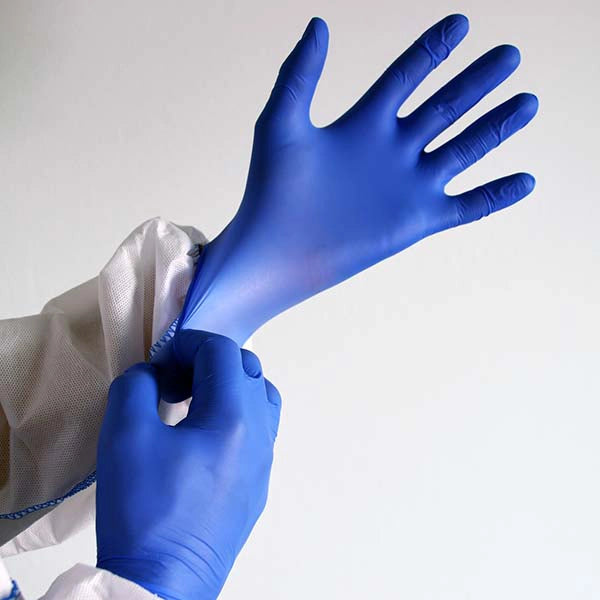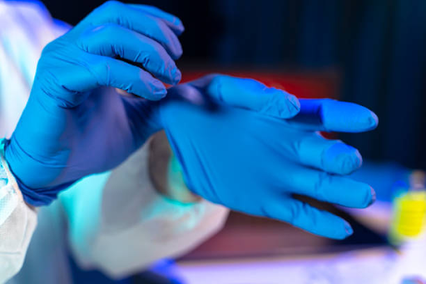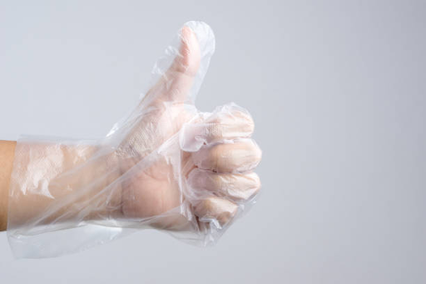Can single-use gloves cause allergies? The answer is yes. Although it’s relatively rare, it’s possible to have an allergic reaction to disposable gloves. Things like latex sensitivities, synthetic rubber accelerators, and excessive friction can all cause unwanted reactions.
This can be frustrating, since protecting your hands from irritating or harmful substances is one of the main reasons to wear gloves in the first place. Luckily, it’s usually possible to sidestep of this problem once you know what causes it. We'll explain what types of skin reactions can occur from glove use, why they happen, and most importantly, how to prevent them.
For those in a hurry: the best gloves for people with allergies are powder-free nitrile gloves. Our nitrile glove collection includes size, color, and style options to suit any workplace, all of them 100% free of latex proteins and irritating powder.
At a glance:
Causes of Disposable Glove Allergies
Preventing glove allergies starts with knowing why they happen. Any of the following can trigger an unwanted reaction to disposable gloves:
Latex Allergies

The vast majority of glove allergic reactions happen to people using gloves made of natural rubber latex. This material is derived from tree sap, which contains substances that can aggravate some people's immune systems. Any skin contact with latex proteins can provoke an allergic reaction in sensitive individuals.
Latex allergy symptoms can vary a great deal in their severity. Some people have mild latex allergies that cause only slight skin irritation. Others could have life-threatening systemic reactions to latex gloves.
Who Is At Risk of Latex Allergies?
According to the National Institutes of Health, about 4-5% of the general population has a latex allergy. However, repeated exposure to latex can sensitize even people who aren't allergic at first Since latex products are common in medical settings, roughly 10% of healthcare workers have serious latex allergies, and up to 17% have mild sensitivities.
The rates are even higher for people with medical conditions that require multiple surgeries or other medical procedures. Additionally, latex condom users and people who work in the rubber industry are more likely than others to develop an allergy to latex. So are:
- People with other kinds of allergies
- Those with asthma
- Individuals prone to eczema
Allergies to Chemical Accelerators
Allergic reactions to non-latex gloves are much less common. Latex-free gloves are most commonly made of nitrile (a synthetic rubber) or vinyl (a petroleum derivative). These synthetic materials contain no natural rubber proteins. Nitrile gloves are the best for people with latex allergies.
Although virtually no one is allergic to vinyl or nitrile, a tiny percentage of the population — less than 1% — may be sensitive to the chemical accelerators used in the production process. Residual traces of these substances in gloves can cause unpleasant reactions to nitrile or vinyl gloves in sensitive users.
Chemical accelerators don't generally pose a risk of severe reactions, even in people with sensitivities to these chemicals. Nitrile glove allergies might cause itching and pain in a user's skin, but they're not life-threatening.
Improper Use of Disposable Gloves

Human skin isn't adapted to being wrapped in materials that block the flow of air and moisture. Using disposable gloves is necessary for many tasks, but wearing them for a long time can cause potential issues such as:
- Friction. Your skin can rub against the inside of the glove, causing inflammation and discomfort.
- Temperature fluctuations. Body heat may be trapped inside disposable gloves, causing discomfort.
- Moisture buildup. Since the sweat on your hands can't evaporate very quickly inside gloves, it tends to accumulate.
- Fungal or bacterial growth. Wearing gloves for too long can allow normally harmless microbes on your skin to build up to irritating levels.
The combination of these issues can lead to dry, cracked skin or itchy, painful sores in people who wear disposable gloves for too long without changing them. This technically isn’t an allergic reaction, but it can easily be mistaken for one.
Types of Allergic Reactions to Disposable Gloves

Understanding which kind of skin reaction you're dealing with may make it easier to treat, not to mention easier to avoid in the future. Here are the four main types of glove reactions to watch out for:
#1: Irritant Contact Dermatitis
The most common reaction to disposable gloves isn't actually an allergic reaction. It usually means you’ve irritated your skin by wearing gloves too frequently or too long without taking precautions.
Symptoms of irritant contact dermatitis will generally show up 12 to 24 hours after exposure. They usually manifest as dry, itchy, irritated skin. Your hands may also look cracked or flaky. The affected areas are usually only in spots where your skin was in direct contact with your gloves.
You can develop irritant contact dermatitis from any type of disposable gloves. The best treatment is to wash your hands with mild soap and take a break from wearing gloves for a few days.
#2: Allergic Contact Dermatitis
This is a delayed allergic reaction to latex additives. It is often more severe, widespread, and long-lasting than irritant contact dermatitis, which results from direct skin exposure to latex. Symptoms can develop up to four days after you've come in contact with latex. In medical terms, this type of dermatitis may be referred to as a Type IV hypersensitivity.
Allergic contact dermatitis often manifests as a painful or itchy rash, sometimes with blisters or hives. Milder cases may simply look like redness or swelling.
Since this is a true allergic reaction, it's most common with latex gloves. However, vinyl or nitrile gloves that incorporate accelerators can also cause allergy symptoms.
Though there's no cure for allergic contact dermatitis, you might be able to reduce your discomfort with soothing creams like calamine lotion or hydrocortisone. Medications like antihistamines and corticosteroids could also reduce the severity of the reaction. These treatments are often available over the counter, but if you're having a severe reaction, you might want to talk with a doctor.
#3: Immediate Allergic Reaction
Also known as Type I hypersensitivity, this type of glove reaction is almost always an allergic reaction to latex. It's a much more serious problem than the previous two, and some of its effects can be life-threatening. As the name implies, an immediate allergic reaction happens more or less right away after contact with latex.
Symptoms of Type I hypersensitivity may mimic those of contact dermatitis, such as skin redness, hives, and itching or pain. But you can also experience systemic symptoms that appear far from the point of contact. Possible effects include:
- Runny nose, sneezing, or other hay fever symptoms
- Red, itchy, water, or puffy eyes
- Cramps
- Sore throat
- Headache
- Chest pain
- Racing heartbeat
- Tremors
- Dizziness
- Major facial swelling
- Wheezing or difficulty breathing
- Cramps
- Nausea or vomiting
If you’re experiencing the more serious symptoms on this list — such as shortness of breath or dizziness — you should head immediately to the emergency room. These can be indicators of anaphylaxis, a potentially fatal allergic reaction. Treatment with injectable epinephrine is also a good idea if you have access to it.
#4: Contact Urticaria
Contact urticaria is another type of minor skin rash. Unlike contact dermatitis, urticaria shows up almost immediately and fades quickly. It usually clears up within 24 hours of removing your gloves.
Urticaria looks like red, swollen, tender bumps on the skin. These are commonly referred to as hives. Other signs and symptoms include a local burning sensation, tingling, or itching.
Contact urticaria can occur due to a mild allergy to natural rubber latex. But it's usually a non-allergic reaction to friction, heat, and sweat inside disposable gloves. The best response is to take your gloves off and wash your hands with soap and water to remove any sweat, microbes, and other irritants.
How to Prevent an Allergic Reaction to Gloves

We’ve already given some suggestions for treating allergic reactions to disposable gloves, but it's always better to avoid them in the first place. Using the following strategies should help you keep your hands healthy and free of irritation:
Wear Latex-Free Gloves When Possible
The best gloves for sensitive skin and allergies are latex-free. Latex gloves are good for many tasks. Their combination of stretchiness, tactile sensitivity, and impermeability makes them perfect for detail-focused jobs like medical exams. Still, as described above, using them carries a risk of allergic reactions. And that risk goes up the more often you use them.
If you want to minimize irritation, you should wear latex gloves only when necessary. At all other times, consider using alternatives like nitrile rubber gloves. Allergic reactions to nitrile gloves are far less common than latex allergies.
Use Powder-Free Gloves
Some single-use gloves include cornstarch powder to make them easier to put on and take off. However, this powder may increase the risk of irritation.
The risk is especially high with powdered latex gloves since the powder could drift through the air, carrying latex particles with it. But even if you're using nitrile or vinyl gloves, cornstarch can cause a problem if it gets into an open wound. Powder-free gloves are almost always better.
Choose Accelerator-free gloves
If you want to be even more cautious about possible negative reactions, you can find nitrile gloves that are made without chemical accelerators. These accelerator-free gloves might cost a little more than standard nitrile gloves, but they'll minimize your risk of allergies.
Change Gloves Frequently
Don't wait until you're starting a new activity or your current gloves break before you put on a new pair. Keeping the same set of gloves on for too long increases the risk of irritation due to the buildup of sweat and microorganisms. In general, it's a good idea to change gloves once an hour at least.
Wash your hands with soap and water for 20-30 seconds at least. Then dry them thoroughly with a paper towel or air dryer before putting on your new gloves. This will lower your risk of irritant contact dermatitis or contact urticaria.
Use Gloves That Fit
Skin irritation can also result from ill-fitting gloves. When the material is too loose, it can bunch up, increasing the friction that may lead to rashes and blisters. It's important to know what size glove you need and buy only those that fit snugly.
Using the right material can also help. Nitrile gloves typically offer the best balance of comfortable fit and lack of allergens for most people. Vinyl gloves are even less likely to contain chemical accelerators, but they don't conform to your hands in the same way.
Appropriate Allergy Precautions Will Keep Your Workplace Safe

How should you avoid allergic reactions to disposable gloves? The answer could depend on your job. If you have a medical practice and can check patients' medical records to make sure they don't have latex sensitivities, you might be able to use powder-free latex gloves with little risk. In a nail salon where you know nothing about customer allergies, nitrile disposable gloves might make more sense.
Whatever approach you choose, you can find something that meets your needs at Gloves.com. We stock a huge variety of high-quality disposable gloves at affordable prices, including latex, nitrile, and vinyl options. Choose the size and style you need to keep yourself and your customers safe and allergen-free.




